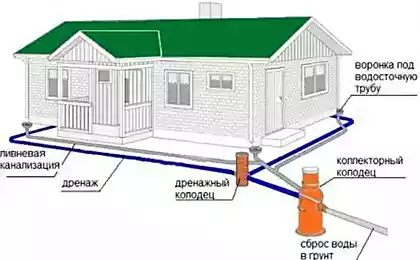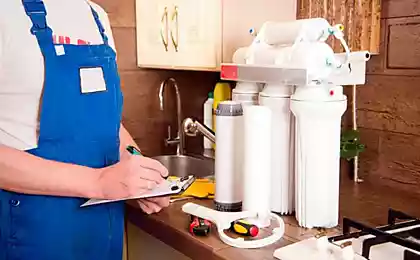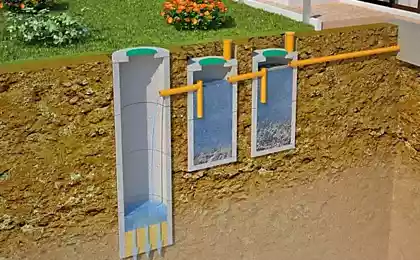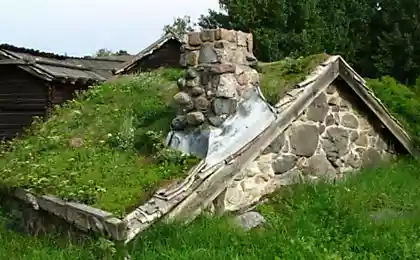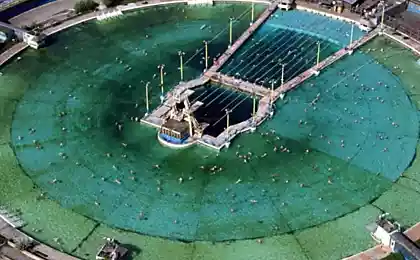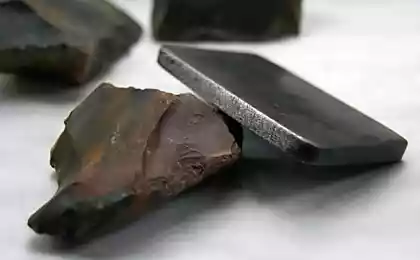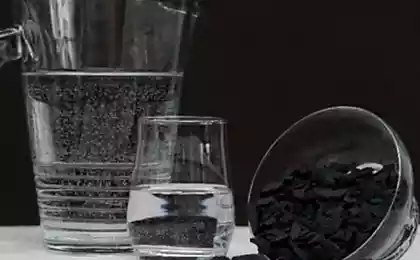592
How to deal with groundwater at the site
The reason the boost and occurrence of groundwaterthe Main source of groundwater is precipitation, which in the spring increases dramatically due to the melting snow. The influence of not only has the volume of precipitation, but the terrain features of the structure confining layers that do not repeat the soil surface, but rather form a set of bumps and hollows.
Water naturally passes through the top layer of the soil reaches the first confining bed (clay), and it flows down to the bottom, forming areas of high humidity.
Ground water rise high in the case where the volume of incoming water exceeds the bandwidth gap: flooded upper aquifers, clogged walkable areas of the soil.

Waterlogged soil is a serious threat to building foundations:
The reference resistance of soil layers subject to strong water erosion, rapidly deteriorating, appear floaters and subsidence, heave becomes uneven. Of wet concrete gradually leached calcium compounds, giving it strength. High humidity is the ideal condition for the development of mold and moss that gives rise to biological erosion concrete blocks. Equally dangerous is stagnant wet soil to fertile soil, because the nutrients are hard to dissolve and are washed out of him, the black soil is compacted. Suffer from severe moisture and rot the roots of trees.
Symptomatic treatment: pumping, drainage, drainagePumping groundwater isGroundwater that accumulates in technical cavities: basements, pits, drainage pits, can be removed from the site through the drain pump.
Power drain pump is necessary to choose the rate of 0.5 to 1.3 m3 per square meter of the area of drained land. This means that from the basement of the house 100 m2 have to pump from 50 to 130 m3 of water in the absence of the arriving moisture.
Surface drainageis Implemented in an open trench depth of 1.5 meters, which aims to overcome the folds of the waterproof layer and to direct the water into the natural slope of the soil. Drain thus can be very large areas, up to few blocks of the cottage village, so often the owners of the plots together and hire equipment for digging trenches.

Land reclamation activitiesare Usually subject to flooding areas are located on the outskirts of human settlements in natural depressions and folds of the terrain. In these cases, water flows down the natural slope, and the trench is directed towards the bottom point and has a constant depth.
In cases where the border of the village far or the terrain precludes the discharge of water into the lowlands use the same drainage ditch, but already have an artificial bias. The water is removed from saturated with moisture in a less saturated area, where it is absorbed into the soil as the current.
Such activities cannot be performed without geodetic leveling, also requires the geological survey to extract detailed topography of impermeable layer. Add to this the cost of mechanized land works and arrangement of passages trenches under roads.
Table of costs for the withdrawal of groundwater artificial slope
Topographical survey of the site, scale 1:500 500-600 RUB./0,01 Hectares Sensing of soil and preparation of the topographic map layer, waterproof from 2000 RUB per 1 Ha for the drafting of the drainage system from 20 000 rubles excavator Services 1000-1500 RUB/1 CH (5-12 meters) Service superintendent was 3000 RUB./shift (8 hours) Cost mortgages tubes 1100-1300 rubles per 1 running. m the arrangement of such trenches will allow you to drain hundreds of plots still the same and will be able to bring its drain to a common system reset. So if you divide the cost of the total number of participants, the amount will be quite lifting. The budget can be cut if you do the excavation work manually, for example, by the members of the dacha cooperative.
Such events provide only a General improvement in geological conditions, local flooding will have to be addressed with additional measures.
How to prevent the accumulation of groundwater in the basement of theBuilding with its weight, albeit slightly, but squander confining layers, which formed a trough, which drained water from the surrounding area. And even if the soil remains relatively dry, precipitation is flocking to the building instead of a uniform infiltration into the soil.
There are two basic methods protect the Foundation from moisture.
Reliable waterproofing of foundations of buildingsIn the construction phase applies the gluing or coating external waterproofing. It can be carried out on the constructed object, alternately obkoma the entire perimeter of the trench width is about 1 meter. This is useful if there is a need to strengthen the Foundation of the building. For buildings without a basement such measure remains the only possible one.
If the building has a basement and access to the Foundation walls, apply the method of injection waterproofing. It lies in the perforation of the wall without violating its fundamental technical qualities. Made the hole fill composition penetrating. Hydrophobizator kristallizuetsya in the pores and almost completely eliminates the ability of concrete to absorb water.
The withdrawal of groundwater from the building with deep drainageAt the perimeter of the building or buried perforated drainage pipe, the connections which are established or technical observation wells. Around elements of the drainage system laid pavement of hygroscopic material — crushed stone or expanded clay. Water seeping into the holes of the pipes supplied by him to wells, then the larger diameter pipes in the sewer and the sewer main. The withdrawal is carried out in the drainage trench, the water can be evenly dropped on a dry area of the soil.
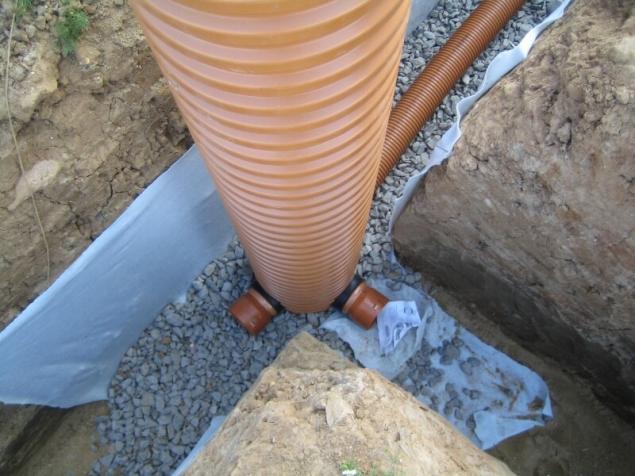
A secondary measure of water drainage from the Foundation surface drainage is protected by the trays and the device blind area.
Both of these methods it is advisable to use not only for the Foundation of buildings, but also to the entire plot as a whole.
The calculation of the cost of arrangement of the deep drainage
Excavation: digging trenches around the house, fastening and filling 1500-2200 RUB/1 running. m perimeter (2 m3 of soil) Granular materials for pavement (gravel, expanded clay) 600-700 RUB/1 running. m around (0.5 m3) Drainage pipe with perforations 170-500./1 RM. m (diameter from 110 to 200 mm) of Drainage wells 5000-1000 over point on the External basement waterproofing 300-650 rubles. per 1 m2 of the Injection waterproofing the basement from 2000 RUB./1 RM. m around (including) Protection of boreholes and wells from groundwaterGroundwater is, in addition, that can cause damage to pipes and concrete rings, may significantly affect the quality of borehole and well drinking water. In the ground water contains large amount of dissolved active substances may accelerate the rate of corrosion of metal, as well as fine silt and mechanical impurities, heavily polluting the water.
There are a set of measures that allows to keep the water clean and prolong the life of the equipment:
Well protect caissons and conductors. They are mounted on the depth of the lower boundary of the confining layer, than stand in the way ground water. The cost of installing the caisson or conductor ranges from 5 to 11 thousand rubles per meter of depth. For protection of the wells used external waterproofing, restore concrete rings that seal the joints between them. Protection of wells average diameter (60-100 cm) from the inner side will cost from 2.5 to 4 thousand per square meter. Exterior waterproofing not only keep the water clean, but will save the ring from destruction. The price increases on the cost of the earthworks. In some cases, helps digging in the immediate vicinity of the storage well for the collection and pumping of groundwater. Due to this, it is possible to drain the surrounding land and to obtain additional source of industrial water. Also around the well you can arrange a security lock. A simple coating of the dome of compacted clay would be taken from the well perched and ground water surrounding areas.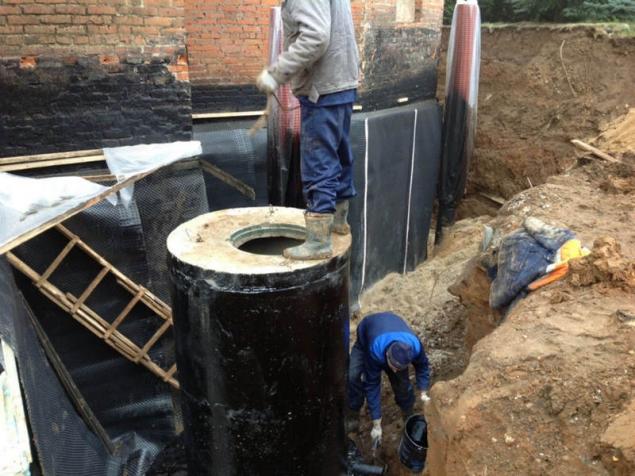
Elimination of problems associated with the soaking of the soilAfter a heavy wetting, the soil loses its fertility, its structure is disturbed. On such plots is strictly forbidden to make fertilizers and organic the dosage should be increased to 5-7 kg per 1 m2 per year. To fully restore the fertile layer will only be for 3-4 years. Thus it is necessary to treat the soil with chemicals that block the development of harmful microflora coming from fertilizers.
Soil structure can be restored by tilling twice a year, a seeding of land plants with fibrous root system. For example, on one summer to sow a plot of hybrid varieties of wheat or rye, bred especially for irrigated fields, it will also speed up the process of recovery of fertility.
At a price of about 500-700 rubles per kg you can buy earthworms-diggers. To increase their populations in the soil will give very good results in restoring the looseness and normal nutrient content. published
P. S. And remember, only by changing their consumption — together we change the world! ©
Source: www.rmnt.ru/story/sewage/850825.htm
Water naturally passes through the top layer of the soil reaches the first confining bed (clay), and it flows down to the bottom, forming areas of high humidity.
Ground water rise high in the case where the volume of incoming water exceeds the bandwidth gap: flooded upper aquifers, clogged walkable areas of the soil.

Waterlogged soil is a serious threat to building foundations:
The reference resistance of soil layers subject to strong water erosion, rapidly deteriorating, appear floaters and subsidence, heave becomes uneven. Of wet concrete gradually leached calcium compounds, giving it strength. High humidity is the ideal condition for the development of mold and moss that gives rise to biological erosion concrete blocks. Equally dangerous is stagnant wet soil to fertile soil, because the nutrients are hard to dissolve and are washed out of him, the black soil is compacted. Suffer from severe moisture and rot the roots of trees.
Symptomatic treatment: pumping, drainage, drainagePumping groundwater isGroundwater that accumulates in technical cavities: basements, pits, drainage pits, can be removed from the site through the drain pump.
Power drain pump is necessary to choose the rate of 0.5 to 1.3 m3 per square meter of the area of drained land. This means that from the basement of the house 100 m2 have to pump from 50 to 130 m3 of water in the absence of the arriving moisture.
Surface drainageis Implemented in an open trench depth of 1.5 meters, which aims to overcome the folds of the waterproof layer and to direct the water into the natural slope of the soil. Drain thus can be very large areas, up to few blocks of the cottage village, so often the owners of the plots together and hire equipment for digging trenches.

Land reclamation activitiesare Usually subject to flooding areas are located on the outskirts of human settlements in natural depressions and folds of the terrain. In these cases, water flows down the natural slope, and the trench is directed towards the bottom point and has a constant depth.
In cases where the border of the village far or the terrain precludes the discharge of water into the lowlands use the same drainage ditch, but already have an artificial bias. The water is removed from saturated with moisture in a less saturated area, where it is absorbed into the soil as the current.
Such activities cannot be performed without geodetic leveling, also requires the geological survey to extract detailed topography of impermeable layer. Add to this the cost of mechanized land works and arrangement of passages trenches under roads.
Table of costs for the withdrawal of groundwater artificial slope
Topographical survey of the site, scale 1:500 500-600 RUB./0,01 Hectares Sensing of soil and preparation of the topographic map layer, waterproof from 2000 RUB per 1 Ha for the drafting of the drainage system from 20 000 rubles excavator Services 1000-1500 RUB/1 CH (5-12 meters) Service superintendent was 3000 RUB./shift (8 hours) Cost mortgages tubes 1100-1300 rubles per 1 running. m the arrangement of such trenches will allow you to drain hundreds of plots still the same and will be able to bring its drain to a common system reset. So if you divide the cost of the total number of participants, the amount will be quite lifting. The budget can be cut if you do the excavation work manually, for example, by the members of the dacha cooperative.
Such events provide only a General improvement in geological conditions, local flooding will have to be addressed with additional measures.
How to prevent the accumulation of groundwater in the basement of theBuilding with its weight, albeit slightly, but squander confining layers, which formed a trough, which drained water from the surrounding area. And even if the soil remains relatively dry, precipitation is flocking to the building instead of a uniform infiltration into the soil.
There are two basic methods protect the Foundation from moisture.
Reliable waterproofing of foundations of buildingsIn the construction phase applies the gluing or coating external waterproofing. It can be carried out on the constructed object, alternately obkoma the entire perimeter of the trench width is about 1 meter. This is useful if there is a need to strengthen the Foundation of the building. For buildings without a basement such measure remains the only possible one.
If the building has a basement and access to the Foundation walls, apply the method of injection waterproofing. It lies in the perforation of the wall without violating its fundamental technical qualities. Made the hole fill composition penetrating. Hydrophobizator kristallizuetsya in the pores and almost completely eliminates the ability of concrete to absorb water.
The withdrawal of groundwater from the building with deep drainageAt the perimeter of the building or buried perforated drainage pipe, the connections which are established or technical observation wells. Around elements of the drainage system laid pavement of hygroscopic material — crushed stone or expanded clay. Water seeping into the holes of the pipes supplied by him to wells, then the larger diameter pipes in the sewer and the sewer main. The withdrawal is carried out in the drainage trench, the water can be evenly dropped on a dry area of the soil.

A secondary measure of water drainage from the Foundation surface drainage is protected by the trays and the device blind area.
Both of these methods it is advisable to use not only for the Foundation of buildings, but also to the entire plot as a whole.
The calculation of the cost of arrangement of the deep drainage
Excavation: digging trenches around the house, fastening and filling 1500-2200 RUB/1 running. m perimeter (2 m3 of soil) Granular materials for pavement (gravel, expanded clay) 600-700 RUB/1 running. m around (0.5 m3) Drainage pipe with perforations 170-500./1 RM. m (diameter from 110 to 200 mm) of Drainage wells 5000-1000 over point on the External basement waterproofing 300-650 rubles. per 1 m2 of the Injection waterproofing the basement from 2000 RUB./1 RM. m around (including) Protection of boreholes and wells from groundwaterGroundwater is, in addition, that can cause damage to pipes and concrete rings, may significantly affect the quality of borehole and well drinking water. In the ground water contains large amount of dissolved active substances may accelerate the rate of corrosion of metal, as well as fine silt and mechanical impurities, heavily polluting the water.
There are a set of measures that allows to keep the water clean and prolong the life of the equipment:
Well protect caissons and conductors. They are mounted on the depth of the lower boundary of the confining layer, than stand in the way ground water. The cost of installing the caisson or conductor ranges from 5 to 11 thousand rubles per meter of depth. For protection of the wells used external waterproofing, restore concrete rings that seal the joints between them. Protection of wells average diameter (60-100 cm) from the inner side will cost from 2.5 to 4 thousand per square meter. Exterior waterproofing not only keep the water clean, but will save the ring from destruction. The price increases on the cost of the earthworks. In some cases, helps digging in the immediate vicinity of the storage well for the collection and pumping of groundwater. Due to this, it is possible to drain the surrounding land and to obtain additional source of industrial water. Also around the well you can arrange a security lock. A simple coating of the dome of compacted clay would be taken from the well perched and ground water surrounding areas.

Elimination of problems associated with the soaking of the soilAfter a heavy wetting, the soil loses its fertility, its structure is disturbed. On such plots is strictly forbidden to make fertilizers and organic the dosage should be increased to 5-7 kg per 1 m2 per year. To fully restore the fertile layer will only be for 3-4 years. Thus it is necessary to treat the soil with chemicals that block the development of harmful microflora coming from fertilizers.
Soil structure can be restored by tilling twice a year, a seeding of land plants with fibrous root system. For example, on one summer to sow a plot of hybrid varieties of wheat or rye, bred especially for irrigated fields, it will also speed up the process of recovery of fertility.
At a price of about 500-700 rubles per kg you can buy earthworms-diggers. To increase their populations in the soil will give very good results in restoring the looseness and normal nutrient content. published
P. S. And remember, only by changing their consumption — together we change the world! ©
Source: www.rmnt.ru/story/sewage/850825.htm
Comparison of thermal conductivity of building materials - study the important figures
Live by the heart

